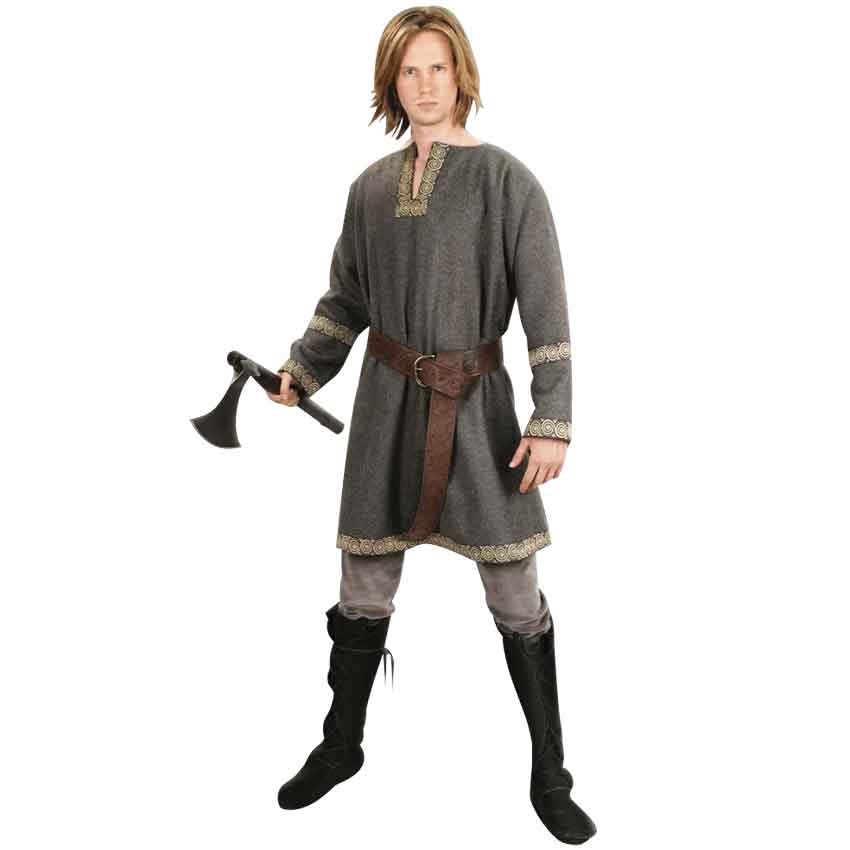
When I first delved into the world of Vikings, I was captivated by their rich history and culture. Among the many fascinating aspects of their society, Viking clothing stood out to me as a remarkable reflection of social status. The clothes they wore were not just practical necessities but powerful symbols that conveyed a person's place within their community. In this blog, I want to share with you how the materials, styles, and adornments of Viking clothing played a crucial role in defining one's social standing.
The Materials of Viking Clothing
One of the first things that struck me was how the materials used in Viking clothing varied greatly depending on a person's social status. For the common folk, such as thralls (slaves) and Karls (free peasants), wool and coarse linen were the primary materials. These fabrics were functional and affordable, making them accessible to the lower classes. However, the wealthier Vikings, including Jarls (nobles) and Kings, had the privilege of wearing garments made from luxurious materials like silk. Silk was a rare and expensive fabric, often obtained through extensive trade routes. When I imagine a Viking noble draped in finely dyed silk, it’s clear how this material signified their elevated status and wealth.
Styles and Garment Construction
The styles and construction of
Viking clothing also provided clear markers of social status. Everyday tunics and trousers worn by the common people were simple and utilitarian, designed to withstand the rigors of daily labor. In contrast, the clothing of the nobility was far more elaborate. Wealthy Vikings adorned themselves with garments featuring intricate patterns and detailed embroidery, showcasing their resources and social rank. I can picture a noble’s cloak lined with fur, fastened with an ornate brooch, standing out vividly against the simpler attire of the lower classes. This contrast in clothing styles vividly illustrates the social hierarchy of Viking society.
Adornments and Accessories
Accessories were another significant indicator of social status among the Vikings. I find it fascinating how jewelry and other adornments were not just decorative but also served as symbols of power and allegiance. The elite wore elaborate pieces made from precious metals like gold and silver, often set with gemstones. These items, such as arm rings and necklaces, were clear indicators of their high status. I can imagine the pride a Jarl would feel when gifting a finely crafted arm ring to a loyal follower, both as a reward and as a public acknowledgment of their bond. On the other hand, the lower classes wore simpler accessories made from bronze or iron, emphasizing their more modest means.
The Role of Color and Dye
Color played a crucial role in Viking clothing, further distinguishing social
classes. Vibrant dyes were costly and labor-intensive to produce, making them a luxury only the wealthy could afford. I find it particularly striking how the rich hues of red, blue, and purple in the garments of the elite stood out as vivid symbols of their status. In contrast, the common folk wore clothes in more natural, subdued tones like browns, greens, and undyed fabrics. This use of color was a powerful visual cue that immediately communicated a person’s social standing to everyone around them.
Symbolism and Cultural Significance
As I explored further, I learned that Viking clothing was imbued with deep cultural and symbolic meanings. Certain patterns and motifs in their fabric and jewelry were believed to offer protection or bring good fortune. During religious ceremonies and important gatherings, those of higher status wore their most elaborate attire to assert their prominence and honor the occasion. This practice not only reinforced the social hierarchy but also highlighted the respect and reverence given to those at the top. It’s fascinating to see how clothing was more than just an expression of style; it was a crucial part of their cultural identity.
Conclusion
In conclusion, Viking clothing was a profound reflection of social status, with every aspect from material to color serving as a marker of one's place within the societal hierarchy. The stark contrasts in attire between the different classes highlight the importance of visual symbols in conveying power, wealth, and allegiance. Understanding these distinctions not only sheds light on the daily lives of the Vikings but also offers a window into the values and structure of their society. Clothing was more than mere attire; it was a statement of identity and position within the intricate social tapestry of the Viking Age.
FAQs
1. What materials were commonly used in Viking clothing for the lower classes? The lower classes typically wore clothing made from wool and coarse linen, which were readily available and affordable materials.
2. How did the nobility's clothing differ from that of common folk? The nobility wore more elaborate garments featuring finer fabrics like silk, intricate patterns, embroidery, and fur, symbolizing their higher status and wealth.
3. What role did jewelry play in Viking society? Jewelry made from precious metals and gemstones was a key indicator of social status, with the elite wearing ornate pieces to display their wealth and power.
4. How did color indicate social status in Viking clothing? Wealthy individuals wore garments dyed in rich, vibrant colors such as red, blue, and purple, while the common people wore more natural, subdued colors.
5. What symbolic meanings were associated with Viking clothing? Certain patterns and motifs in Viking clothing had protective connotations or were believed to bring good fortune, and
elaborate attire was worn during significant events to assert prominence.